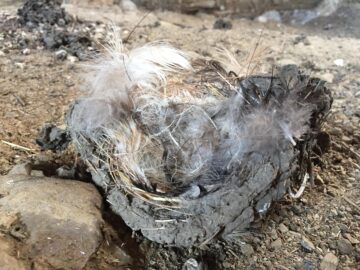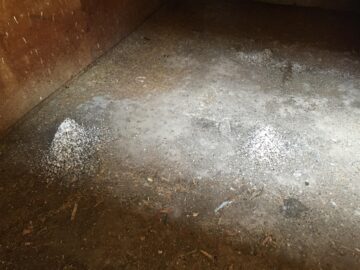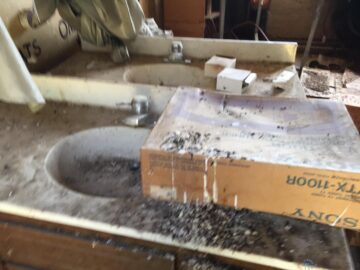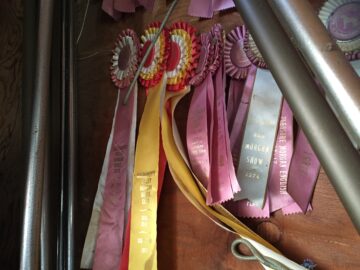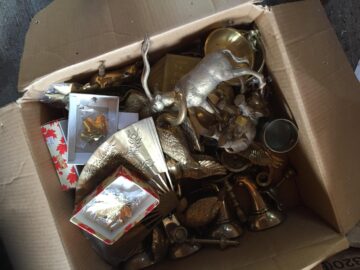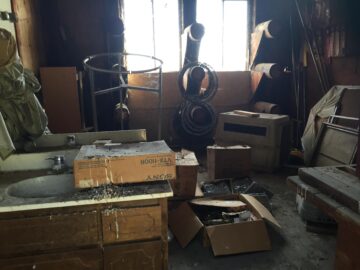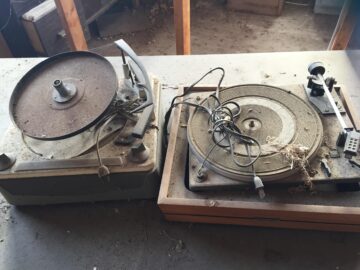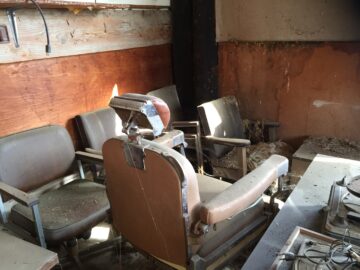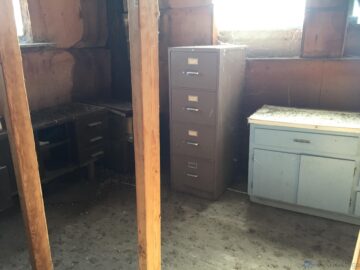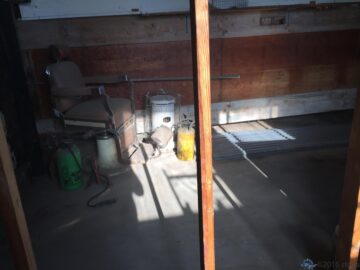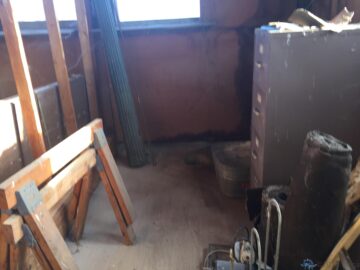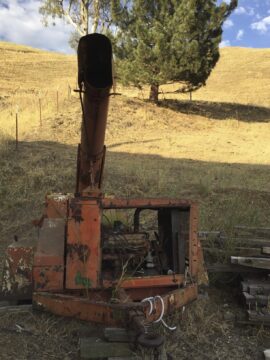Continuing on from the previous two posts….
The last two areas of the stables to be cleaned out where the office and old tack room. Both of these, unlike the stalls, have poured concrete floors and are fairly sealed off from the elements, although the wall gaps allow the barn swallows to flitter in to at least the tack room to build their nests as evidenced by the giant quantity of bird crap in that room. (First pic below is a shot of an intact swallow nest that had fallen from the rafters onto the floor of one of the stalls.)
To give you a rough idea of what I mean, the second pic is a shot of the one of the stalls that had nothing much in it when we started the cleanup. Those piles the of white and grey that look a bit like pebbles or perhaps ash–those are piles of bird crap accumulated over the years. The combined smell of the guano, moldy hay and dust is very pungent and not super pleasant. The tack room, because the door is usually closed, was perhaps the most awful smelling area in the stables. Bird poop coated almost everything and for extra measure there was a large pile of old coyote feces in one of the corners.
While some of the stuff left in these tack room and office dated back to when the Doc owned the property, quite a bit of the junk was definitely left by the previous owners. The vanities from some of the bathrooms in the house had been stashed away in the tack room, as had some dilapidated patio umbrellas and old audio components, plus one entire wall covered in old competition ribbons from the early 1970s (fourth and fifth pics). These were most likely won by the Doc’s daughter.
Apparently at some point someone ran a clothing and tchotchke boutique, and the remnants were stored in the tack room. We pulled out about a dozen retail style garment racks including a large circular unit plus four boxes of solid brass knickknacks. There was also a plethora of old shelving rails and tables, plus a tiny and very broken children’s desk, random bits of barbed wire, and a brass headboard. While we kept a few things from the room, like the 6 boxes of skeet and the brass bits (last pic), a lot of the stuff was just garbage. What might have been useful when first stored in the room was now so dirty that trying to salvage it wasn’t worth the effort. We did leave the ribbons on the wall though.
Here are before and after shots (although the boxes on the floor of the after shot were the ones full of the brass stuff and we’ll post more on that at a later date.)
The office, compared to the tack room was a much simpler space to clean up. It mainly contained old furniture with a few oddities like these old turntables that, like just about everything else in the space, had festered in the dust and guano for so long they were now just bits of junk.
We do know, according to the Doc, that ranch was sold in the mid-1980s due to a divorce and that it was sold to a real estate agent. Right now we’re operating under the assumption that that agent was the PO’s father, and we’re pretty certain he used this room as his business office. We know from the records left in the desk and filing cabinets that he specialized in mobile/prefabricated homes and considering there were once several mobile homes scattered about the property (and rented to random people), all those pieces seem to fit together.
We do know said real estate agent eventually sold/gave the property to his son, but county records are a bit unclear. There may have been another person involved before the PO’s father had possession, so at some point I will take my giant spreadsheet of document numbers that may be related to the property and visit the county records building. Right now there is a bit too much going on to play house detective to that degree.
I did manage to dig up some more info on the Doc’s first marriage/family though and I may eventually work up the courage to call his first wife and invite her out to visit–perhaps just not when the retaining wall is being rebuilt.
Anyway, back to the contents of the office that provided the diving off point for my tangent. Cleaning it out was pretty easy and it was actually the very first area we tackled. Once it was cleaned out we then used it as safe storage area for anything we found in the stalls or tack room that was worth keeping.
Here are some after shots of the tidied up space.
So there you have it…somewhat clean stables. At least, thanks to some paid help, we no longer are the keepers of so much garbage and the work went far more quickly than if I had done it by myself. It was often faster for me to just stand in a stall and point to an item and say “dumpster” and one of the guys would carry it out and place it in the dumpster. Anything worth keeping we’d carry into the office. In some cases, like the stall full of pots, I’d be in the back of the stall tossing things towards the door and the guys would then pick up stacks and get them in the dumpster. Even more useful was their ready application of a hammer to break down the old desks and tables to better fit in the dumpster. I plan on using them again when I finally tackle the mess behind the stables where we have lots of rotting lumber are fun things like old bathtubs and giant broken wood chippers.

